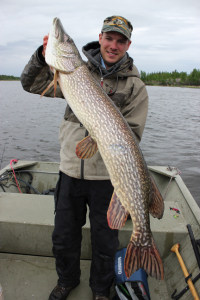Post
Pike Lure Patterns
Fishing Tackle Reviews, Freshwater Fishing Articles, Freshwater Fishing Tackle Reviews, Freshwater Tackle Articles theangler PM

It’s camouflage, allowing it to propel itself from weeds into prey suddenly to surprise, confuse, and add weight through momentum. Shock-and-awe, aquatic style. Nothing aids that approach more than a bright, green stand of weeds, creating a smokescreen for ambush.
Myth has it pike lose their teeth in summer, which has no basis in science. But it drives traditional angling pressure, which peaks spring and fall. That alone could make summer the best time to dust off your pike gear. Pike are less pressured and always hungry until waters warm above 78°F or so, at which point metabolism begins to backtrack.
Between Iowa and central Canada, summer pike display three primary patterns in big water. Some move out over basin areas to track suspended schools of pelagic baitfish. Some move deep, to main-lake flats surrounding structure—typically into depths of 40 to 60 feet. But some always remain shallow and within reach of the weekend warrior, haunting the dark shadows of deep weed edges wherever cabbage, coontail, milfoil, and other deep-growing weeds thrive.
When the wind blows into a deep weedline for three days straight or longer, all three patterns can coalesce into one, big free-for-all, making weedlines the place to be. At other times, after water temperatures climb above 64°F or so in spring, anglers need to decide which pattern they want to address in big water. In smaller lakes, pike pretty much stick to weeds. In big water, weeds come first, meaning pike pass through a weed phase before heading out to sea, so you can always find some pike munching at the salad bar.
Location for summer pike on weedlines is fairly easy. Stick with main-lake weedbeds that border or come closest to main channels or sharp drops into the main basin. That eliminates bays, backwaters, most shallow weed beds, and at least 50% of the main lake itself. Look for structurally-diverse areas. Rocky points, reefs, gravel bars, or any hard-bottom structure intercepting a healthy weedline can be a prolific spot for big fish.
After locating a deep weedline that meets those criteria, comb it for pockets, points, and spots adjacent to the steepest drop-offs. Places where the weeds are healthy and dense attract the most prey and, therefore, the most active pike. Don’t be intimidated by dense weedgrowth. Rip a single-hook bait right through the weed tops and pike will come snarling, slashing, and tearing into it—sometimes even when it has weeds draping from it.
As mentioned, the best presentations have single hooks. And the fastest way to cover a weedbed, of course, is with a spinnerbait. Pike love spinnerbaits, and the spinner arm protects the hook so it can be ripped through cabbage more efficiently than most baits. Even the biggest pike surprise us and get patterned on smaller, single-blade spinnerbaits like the Booyah Single Colorado, but effective sizes range right up through the big Lindy Musky Greats.

When pike feed on perch and walleyes, they position closer to bottom at the base of the deep weed edge. Put the trolling motor down, position the boat right on the edge and cast ahead of the boat white the angler in the back pitches over the top. Fishing the base means slow rolling with a less-resistant bait, like the Booyah Bait Company Double Willow Vibra-FLX.
Whenever the bait engages weeds, ripping it free can trigger explosive strikes. But it can also send the clip sliding up the arm of the spinnerbait. Either wrap wire around the R-bend bend (where bass anglers tie directly to the bait) or crimp metal beads to each side of the R-bend to keep the clip on your wire leader from sliding up the arm when casting or ripping weeds. Wire leaders should have heavy-duty, 200-pound or better snaps and swivels. A 12-pound pike can hit a spinnerbait with enough velocity to bend weak clips open. Imagine what a 30 pounder can do. You can tie directly to R-bends with steel or titanium wire, too, but it can still slide. Using spinnerbaits with closed loops or just closing the R-bend works best.
You can use the big 1-ounce Booyah baits, even crimping lead to the hook shaft to add more weight, to burn the bait as fast as you might with a bucktail spinner. Cast out over the weeds, point the rod tip at the water, and use a high-speed reel to sizzle the bait back as fast as the blades will allow. Breaking the surface now and then is not a no-no in pike fishing. Having the blades “re-engage” as you slow the bait back down is a decidedly effective trigger for pike in the weed tops.
The best spinnerbait retrieves for pike are achieved with the rod tip down. Even when slow-rolling a bait along weededges extending down to 15 feet or deeper, holding the rod tip low: 1/ Allows you to keep the bait deeper, 2/ Keeps you in a better position to set the hook, and 3/ Puts you in the best position to sweep the bait right or left, changing its direction. Sudden changes of direction and speed trigger lots of strikes. It’s rare for a steady retrieve to work best in summer, though it does happen.
The best retrieve some days starts with acceleration. Accelerate a slow-rolling spinnerbait, then stop it completely while keeping the line tight. That forces a following pike to make a decision: Turn or eat. Try anything and everything to trigger pike until you hit on the retrieve that drives them out of the weeds to slash, rip, shock, and awe.
